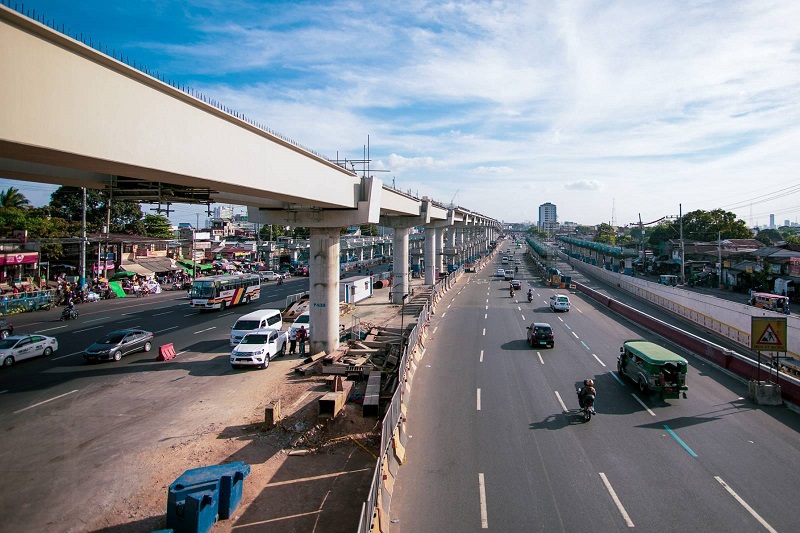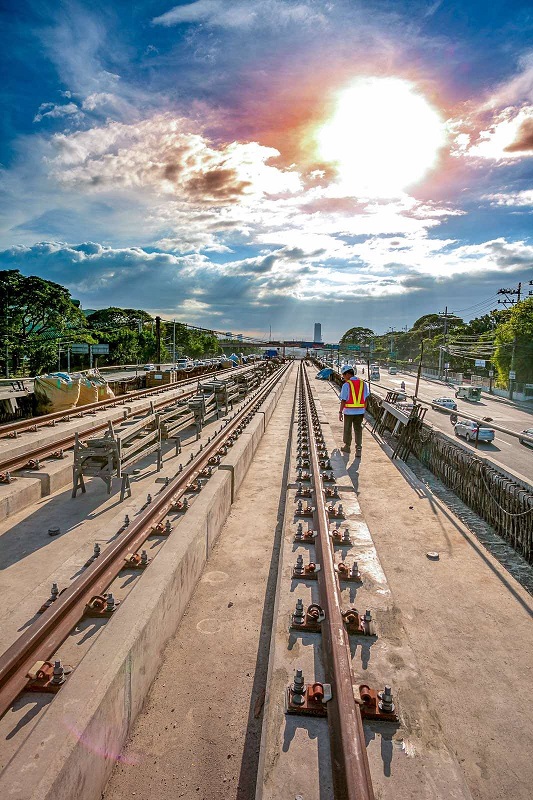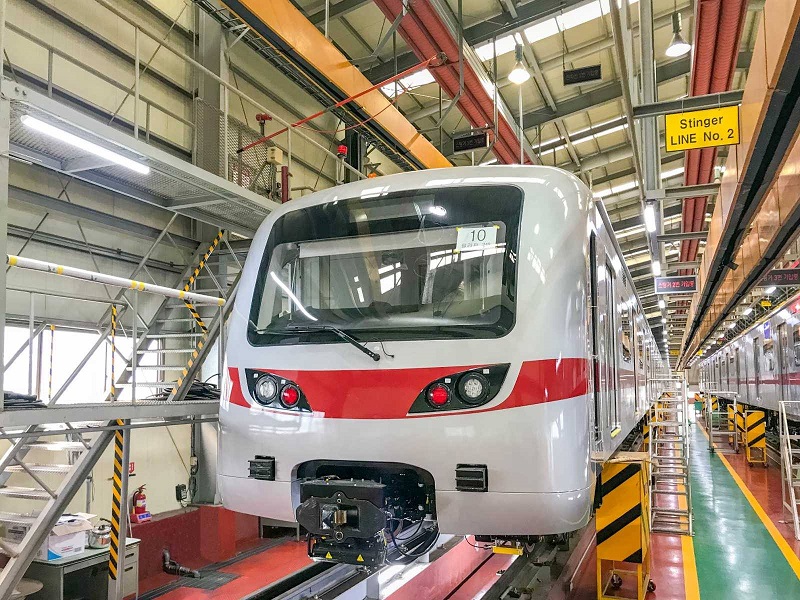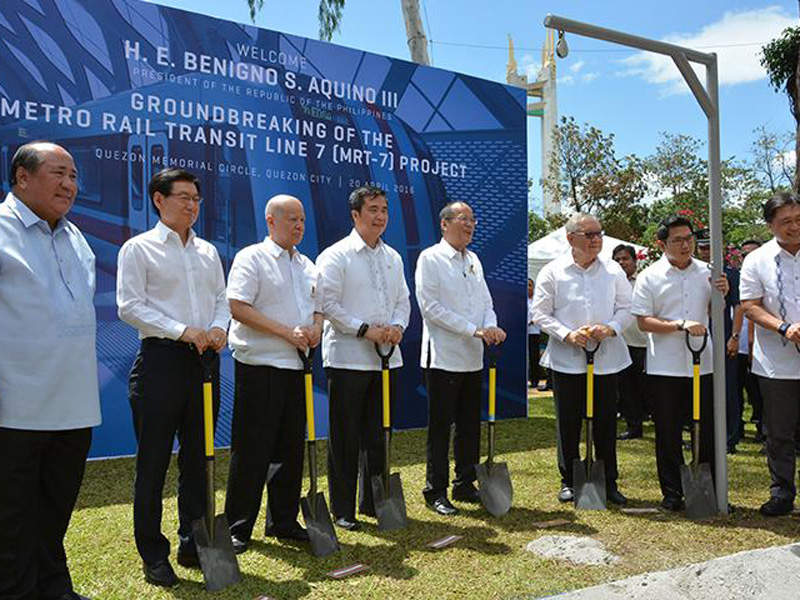Last Updated on March 10, 2021 by OJ Maño
San Miguel Corporation (SMC) has announced the opening date of the Metro Rail Transit Line 7 (MRT 7) on December 2022. The P63-billion elevated rapid transit project will link North Avenue in Quezon City to San Jose del Monte, Bulacan, serving hundreds of thousands of passengers per day. It is projected to reduce travel time from Quezon City to Bulacan to 35 minutes.
“We’re confident we can achieve full, complete operations by December next year,” said SMC president and chief operating officer Ramon S. Ang.
SMC: MRT 7 project 54% complete, opening set for December 2022
Work on the MRT 7, another massive, game-changing, privately-funded infrastructure project of San Miguel Corporation (SMC), has crossed the halfway mark, with civil works now 51.73% completed and electrical/mechanical (E&M) works 55.31% done.

“Our progress for the MRT 7 project as of January 2021 is at about 54%. We have already completed a significant amount of civil works, including the installation of bored piles, girders, foundational works on stations, and we have been installing rails or tracks. At the same time, E&M works have also advanced significantly,” said SMC president Ramon S. Ang.
Ang said that some 6.2 kilometers of the target 13.5 kilometers had been completed for the project’s elevated section. For the at-grade sections, 4.8 kilometers of the target 6.9 kilometers has been completed. Meanwhile, 1.5 kilometers out of the 1.9 kilometers tunnel portion is done.
“Compared to our recently-completed Skyway 3 project–which is one of the most difficult we’ve had to undertake because of changes to its alignment and the engineering solutions we’ve had to employ to mitigate right-of-way (ROW) problems– the MRT 7 project is actually more complex,” Ang related.
“Apart from complex construction work, MRT 7 construction involves a lot of mechanical and electrical work. There are so many systems to be integrated to ensure we can efficiently and safely run a large number of passenger trains to serve the public,” Ang explained.

Ang added that despite delays to construction and workforce limitations caused by the pandemic, work on the MRT 7 has continued at a steady pace, as part of SMC’s commitment to continue all its projects and investments, to generate jobs, boost economic growth, and help in the country’s recovery from the COVID-19 pandemic.
Once complete, the MRT 7 project will make daily commutes from Quezon City to San Jose del Monte, Bulacan faster and easier. It will link up with MRT-3 and LRT-1, providing greater access and seamless travel. It is also seen to spur economic growth in Bulacan, as businesses and residential developments are seen to further grow in the area, contributing to Metro Manila’s decongestion.
“Now that we’ve crossed the halfway mark, we’re expecting to reach a lot of major milestones for this project this year. This includes the construction of the stations, testing of various equipment in different countries, and the actual arrival of this equipment, including the first batch of trains,” Ang revealed.

Ang said that factory acceptance testing (FAT) of an initial six trains or 18 cars is scheduled for April in South Korea. SMC purchased the trains from South Korea Hyundai Rotem, with its national rail manufacturer, Korea Railroad Corporation (KORAIL), serving as its adviser. If the trains pass the tests, which will be witnessed by KORAIL officials, SMC, and the Department of Transportation (DOTr) representatives, the first batch of trains will arrive within the year.
More trains will then be delivered every month. SMC is procuring a total of 36 trains or 108 cars for the project. The company said its depot would be capable of holding up to 150 trains for future capacity expansion if needed. Meanwhile, manufacturing other important equipment, sourced from various countries, has also been completed, Ang said.
These include ticket vending machines and automatic gates, with factory acceptance tests scheduled within the first quarter of this year. Manufacturing and testing of communications systems have also been completed. Initial batches of third rail equipment—responsible for delivering electrical power to the trains—and track works such as rails and fastening assemblies have also been completed.
Various other railway operations equipment such as those needed for automatic fare systems, communication systems, signaling systems, power supply systems, third rail, track works systems, and rolling stock maintenance equipment—used for the maintenance of trains–are set to be delivered from various countries throughout the year.
“There is still a lot of work to be done. And on top of that, similar to Skyway 3, there are still many right-of-way (ROW) issues pending for the MRT 7 project. But we will continue working; we keep on building and doing what we can in areas where we can work so that we can finish this faster,” Ang said.
“Given our progress today, and all the major milestones we’re expecting this year and the next, I think we’re confident we can achieve full, complete operations by December next year, with our first test run scheduled for June next year. By then, I believe we would be recovering already from the impacts of COVID-19. Our economy will be on the way up, and people will be resuming their lives in the next normal. MRT 7 will be ready for them, to help make commutes faster, to boost our economy, and bring growth to more areas,” Ang said.
MRT 7 Build Build Build Project
The project is owned and managed by the Department of Transportation (DOTr), formerly known as the Department of Transportation and Communication (DOTC).
The Metro Rail Transit Line 7 (MRT 7) project involves the financing, design, construction, operation & maintenance of the 23-kilometer elevated railway line with 14 stations from San Jose Del Monte, Bulacan to MRT 3 North Avenue in Quezon City and the 22-kilometer asphalt road from Bocaue Interchange of the North Luzon Expressway (NLEX) to the intermodal terminal in Tala. The road component will divert northern provincial buses operation to San Jose Del Monte, thereby decongesting EDSA.
The project was developed through a Public-Private Partnership (PPP). The private concessionaire Universal LRT Corporation BVI Limited, a subsidiary of San Miguel Corporation (SMC), won the bidding. The 25-year concession agreement was signed between the Republic of Philippines (ROP) through the Department of Transportation and the BVI in 2016 under the Build-Gradual-Transfer-Operate, Maintain and Manage (BGTOM) scheme.

According to Railway-technology website, “The construction of the MRT line 7 began at the children’s Garden of the Quezon Memorial Circle in Quezon City in April 2016. The groundbreaking ceremony was attended by Benigno S. Aquino III, the president of the Republic of Philippines.”
Sources
- Manila Metro Rail Transit (MRT) line 7. (2021, February 22). Retrieved February 23, 2021, from https://www.railway-technology.com/projects/manila-metro-rail-transit-mrt-line-7/
- MRT line 7. (n.d.). Retrieved February 23, 2021, from https://ppp.gov.ph/ppp_projects/mrt-line-7/
- https://ppp.gov.ph/wp-content/uploads/2018/03/PPPC_pub_brochure_Feb_2018.pdf
- P63-B MRT-7 now 60% complete. (n.d.). Retrieved February 23, 2021, from https://ppp.gov.ph/in_the_news/p63-b-mrt-7-now-60-complete/
- Charm, N. (n.d.). MRT-7 North ave. to SACRED HEART, CALOOCAN seen running by Dec. Retrieved February 23, 2021, from https://www.bworldonline.com/mrt-7-north-ave-to-sacred-heart-caloocan-seen-running-by-dec/
- Marasigan, L. (2017, June 08). SMC’s Ang vows to OPEN MRT 7 line in two years: Lorenz S. Marasigan. Retrieved February 23, 2021, from https://businessmirror.com.ph/2017/06/08/smcs-ang-vows-to-open-mrt-7-line-in-two-years/
- Comms. (n.d.). Gov’t, stakeholders Conduct bored PILE concrete POURING AT MRT 7 Batasan Station. Retrieved February 23, 2021, from https://dotr.gov.ph/2014-09-02-05-02-02/2014-09-03-06-36-40/2014-09-03-06-38-40/2014-09-03-06-39-26/48-dotr-latest-news/303-gov-t-stakeholders-conduct-bored-pile-concrete-pouring-at-mrt-7-batasan-station.html